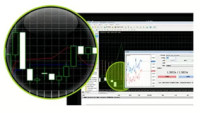 An order corresponds to the manner in which one starts and completes a trade on the Forex. They are essential to enable you to systematically check your different sale and purchase positions and choose the time to open and close one or another position in an automated manner.
An order corresponds to the manner in which one starts and completes a trade on the Forex. They are essential to enable you to systematically check your different sale and purchase positions and choose the time to open and close one or another position in an automated manner.
Generally, one distinguishes between the limit orders and the stop orders. In this chapter we will explain the most common orders and those more particular.
Limit, stop and OCO orders
These two order types can be used at the same time to open or close a given order.
The stop orders
The stop order, also called “stop-loss orders”, intervene in the sale or purchase when a market reaches a certain predetermined level. Therefore, the stop order has the main function of placing a limit beyond which the market is no longer favorable any more for you. In this way you limit your losses.
Let us take a simple example
If we purchase 1,000 EUR/USD at 1.5180 and we place a stop order at 1.5100, the position will be automatically closed or completed as soon as it reaches this limit thereby avoiding a higher loss.
The limit orders
The limit order, to the contrary, consists of placing an automated sale or purchase order as soon as a certain threshold level is reached or exceeded. In this case therefore it is not a question of limiting the losses but of maximizing the profits.
Let us take a simple example
If the EUR/USD pair is at 1.2751 and we anticipate a drop in the Euro at 1.2532 followed by a rise, we place a limit order at this level to buy the Euro at this point.
OCO orders
The OCO orders (‘One Cancels the Other’) are used to frame a stop order position on one hand and a limit order on the other to afford maximum security to your eventual profits and losses. Of course, the implementation of one of these two orders automatically cancels the second.
Let us take a simple example
If we have an open position of 1,000 EURO/USD priced at 1.5370, we can for example place the following orders:
Sell stop order at 1.5450
Purchase stop order at 1.5200
In this precise case, the OCO order enables us to secure ourselves against a loss if the price of the EUR/USD reaches 1.5450 whilst ensuring profits as soon as it reaches 1.5200.
The orders we just explained are applicable, as you have seen, to open positions. However, there are different orders enabling the opening of positions.
For an optimal use of this type of order, it is important to determine the threshold above which a price cannot climb, called “resistance level” and the level below which it cannot descend, called the “support level”. Each time the price of one of this two levels is reached, an order is automatically released.
Caution! This technique is not without risk. In fact, the support and resistance levels can change over time and this happens even if they remain at the same level for a very long time. It is therefore essential to remain vigilant.
The other order types
The “if done” orders
The “if done” orders: An “if done” order is obligatory constituted of a limit order added to another type of non-active order. The principle is simple: As soon as the limit order is executed, the associated order becomes active. Here, the associated order can be a limit order, a stop order or an OCO. The advantage of the ‘if done’ order is that you do not have to permanently monitor your limits.
Let us take a simple example
If the EUR/USD is priced at 1.5270, we place a limit purchase order at the resistance level of 1.5400. We associate a stop order with it at 1.5270. In this way, the limit order is started as soon as the position reaches the resistance level and on this same position it automatically activates the stop order which is associated with it. The ‘is done’ order given is an excellent way to make profits without risking loss in the event of new fall in the price.
The Trailing Stop Order
The Trailing Stop or Trailing Stop orders: This order is another excellent way of limiting your risks. This order has the effect of proportionally increasing the rate of the pair to which it is attached. Used in another way, it automatically blocks when the rate of the same pair falls.
Let us take a simple example
We place a trailing stop order at 1,5000 on the EUR/USD pair opening for purchase at 1.5270. If the rate continues to rise to 1.5070 then my stop order will equally stop at 1.5070. However, if the rate should fall the trailing stop order will remain blocked at the last position. In this way we take no risks.













